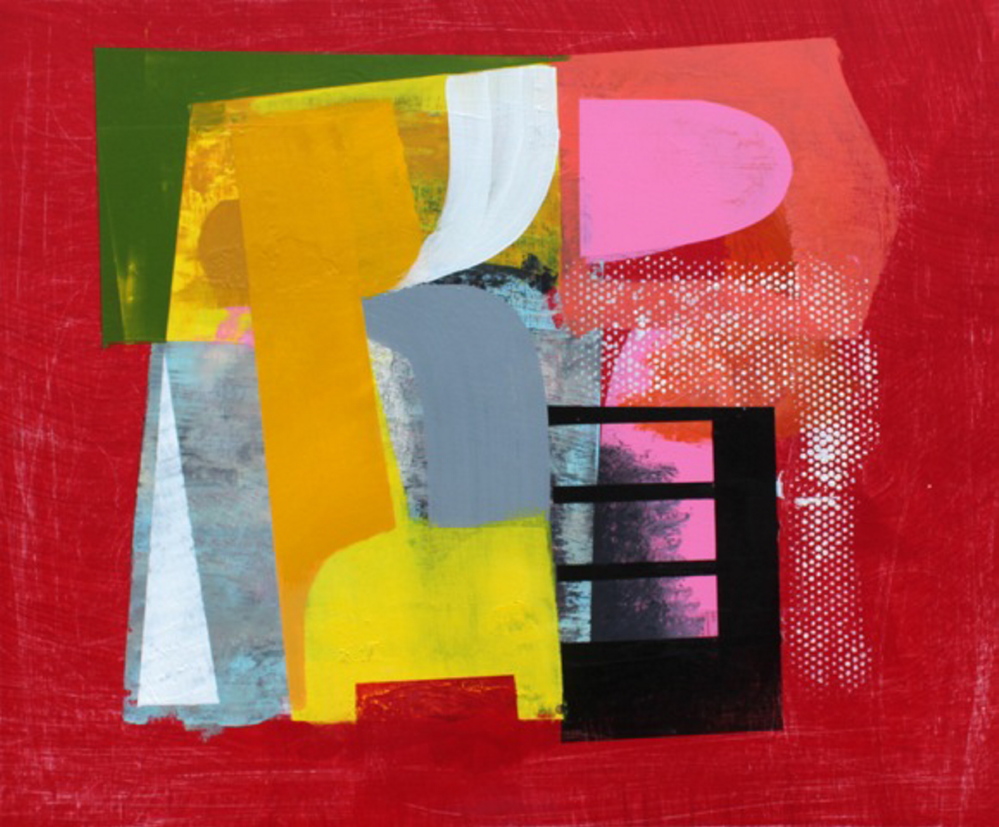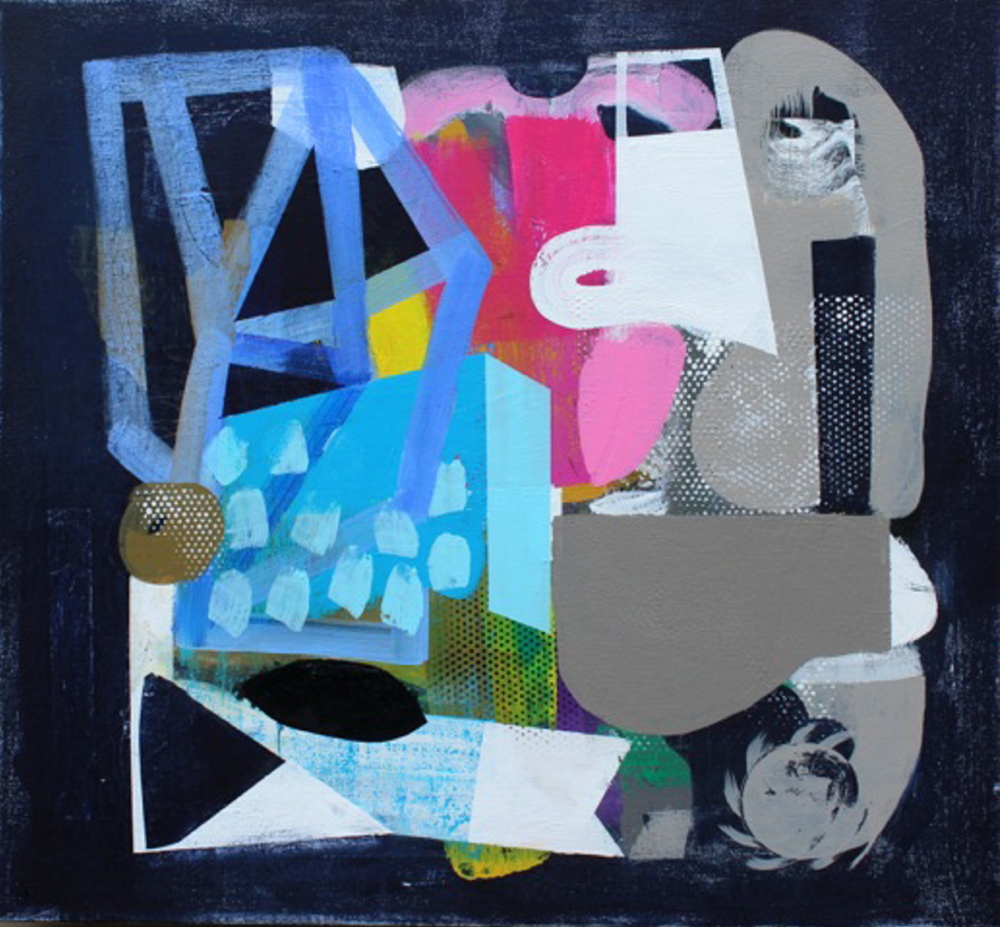Slightly wider than it is tall, Tom Flanagan’s painting “Tumble” is 20 inches by 24 inches. Clearly bound black, white, blue and pea green abstract shapes are all knit together to make a sort of figure in the center of a gray ground. Certain passages are textured as though painted through a screen (or printed with tape you might use to patch drywall). A cartoonish black boot at the lower left dares you to turn the jumble of shapes into a human figure. In fact, the screen-textured opposite form could be read as the other boot and a drop-shape on the right could pass for an arm. You quickly get the idea the painting isn’t daring you, but, rather, welcoming you to read it as a person. Once you do, however, the forms tumble back into their own components and the figure breaks down into elements of abstraction.
The water that you thought had caused the tumble is a loaded brushstroke of blue and white. A fleshy pink form is just a bit of anthropomorphic drawing. A white area is defined by the dark negative space of its interior shape. The echoing of light blue forms becomes more poetry than dance. And textures begin to get interesting for their own qualities. Even the background rolls in over the effervescent textures like a fog – a palpable entity rather than the background for something else.
With most paintings, the subject comes into focus, and that becomes the standard against which we gauge the handling of the paint to get a reading on the intent and interests of the artist. But something else has happened here. Flanagan has feinted toward making a representational painting and then pulled it back. And this process reveals a great deal about how we look at paintings – not unlike the way a quarterback’s head fake acknowledges an attempt to fool the people trying to get a read on his next move.
But Flanagan seems to be doing everything he can to put the viewer in the same place as the artist; instead of withholding his intentions, his personal truth is the line of inquiry that he shares with us: There is a fine line between a feeling and a thought.
This is at the very foundation of Tom Flanagan’s art. It drives his content. He uses the non-verbal power of paintings to challenge us to compare how we think about feeling versus how we feel about thinking.
Flanagan’s art is all about process. But his process is not the technique of applying paint with a knife or a brush. His painterly process is like a conversation: supposition, interaction, response, gesture, conclusion and so on.
In many ways, this is typical for painting in Maine, particularly landscape painting, but the traditional goal of description holds the viewer at a distance from the artist’s vision. It may seem ironic, but with abstract painting, it is easier to follow the intentions of the painter. Like a story, landscape is transportive. It is there-and-then. Conversely, abstraction – like a conversation – engages us with the here and now.
Flanagan’s suite of paintings on view at Susan Maasch Fine Art makes a strong case that visual intelligence in painting does not have to be hidden under opacity and nuance. Painted in bold colors, his six paintings are approachable in scale. They feature clearly painted forms massed in the center of the canvas. Superficially, they look very much like synthetic cubism, the later phase of Picasso’s and Braque’s seminal work, when they shifted their cubist paintings away from the minimal requirements for legibility and took a walk on the wild side of painterly possibility.
Flanagan’s paintings act like paintings. They are lively, well-executed, colorful, rhythmic, appealing, handsome and satisfying. They are not so chaotic as to appear confused. But they are not so simple as to be obvious. They have motion and energy (what the French call “esprit”) and playful wittiness (what the Germans call “geist”).
Flanagan’s reliance on European models is meaningful and sound. The American model (or meme?) of painting, after all, turns away from cultural interaction and inward toward self-expression in order to rely on an individualist myth of authenticity – original ideas inspired by no one but the artist himself. It’s an appealing model if you’re trying to sell art to ignorant narcissists who know nothing about art. In fact, the less they know, the more appealing it is. And that’s why it’s not only a misleading myth, but a damaging one as well. (Learning about art is half the fun, not something to be shunned.) Art is a facet of culture, and culture is about shared human experience. Painting is about communication and human interaction. If you really wanted to do something alone, why would you make a painting about it?
“Things I Might Have Said” superficially resembles “Tumble,” but it is geared more to structure than a figure. Its black background gives a broader sense of context (like that of night compared to a specific place). A cereal box-like form has a grid of brush-thick strokes on it, so it acts like an apartment building. An architectonic form writhes in the upper left, twisting on itself like a Ken Greenleaf drawing (and if it really is a reference to his fellow Maine painter, then kudos to both!). While the forms all seem to be recognizable in one way or another, they show no inclination to work together to create a legible figure. Their ultimate momentum is not toward coherence but fragmentation: The dish becomes a recipe. And by so displaying his intentions, Flanagan’s process resembles reverse engineering.
Another piece with a black background and a Matisse-like palette of vivid pinks, greens, oranges, reds and purples uses a Greenleaf-esque drawn book shape near a white rectangle smeared somehow to appear like music (a deliciously synthetic cubist gesture). But the main drama occurs among the forms: The tips of pink and orange triangles lean away from each other like duelers, with the orange falling just outside an intersection of red and brown geometric forms. It’s such a tiny detail, but when it is discovered by the viewer, it assumes an unexpectedly impressive power by its razor-sharp decisiveness.
Synthetic cubism was bright and playful. It was witty and exuded creative intelligence. And it changed everything. While neither Picasso nor Braque ever crossed over to abstraction, their late cubist work inspired abstraction to appear almost simultaneously wherever Western painting held sway as a leading cultural phenomenon. How that happened, however, is a question that is rarely (if ever) answered adequately in introductions to art and art history.
If you want to answer that for yourself, spend some time with Flanagan’s paintings.
Freelance writer Daniel Kany is an art historian who lives in Cumberland. He can be contacted at:
dankany@gmail.com
Send questions/comments to the editors.





Comments are no longer available on this story